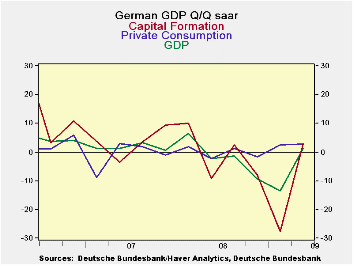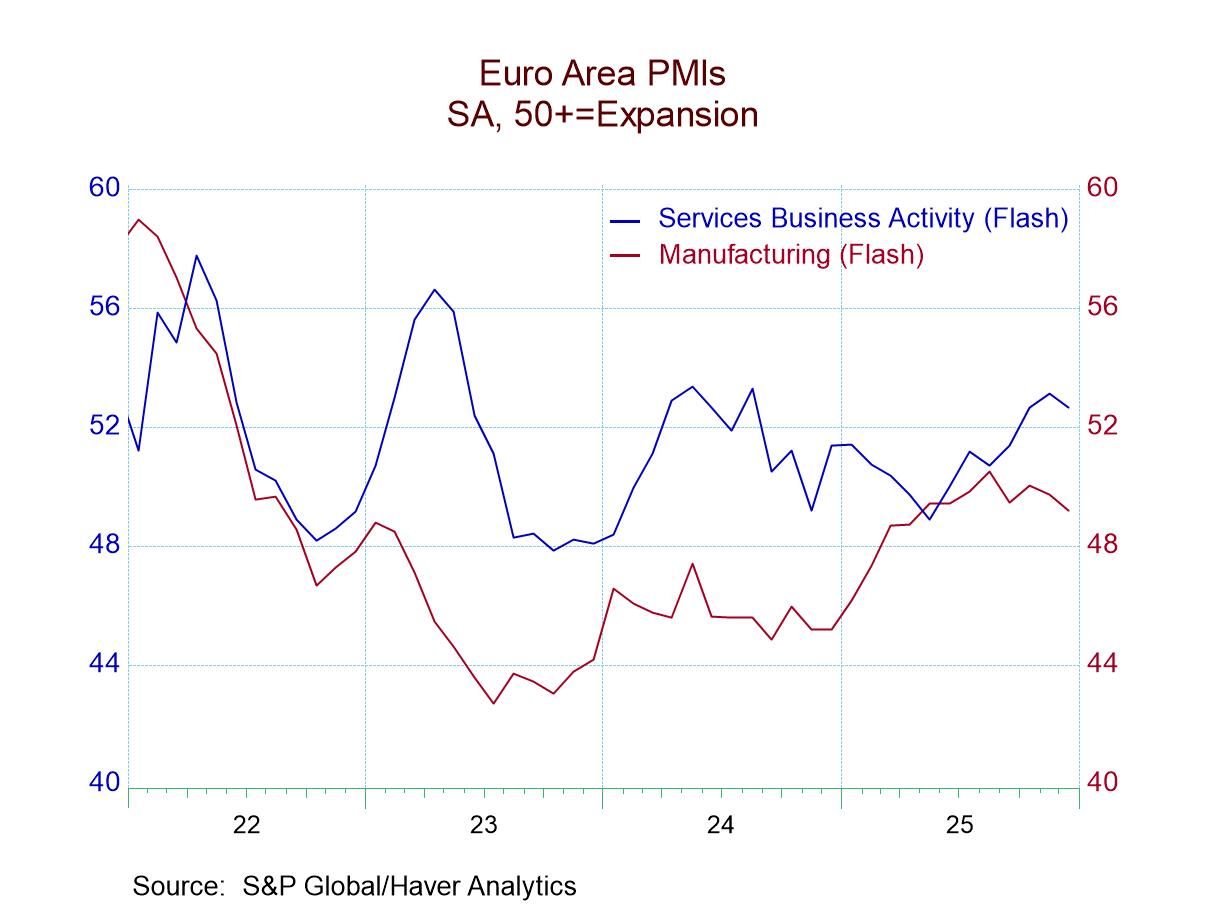 Global| Aug 25 2009
Global| Aug 25 2009Jumpin' German GDP
Summary
German GDP’s turnaround reveals its secrets – Germany finalized its GDP and provided details on Q2 GDP performance. GDP rose by 1.3% annualized and compounded Q/Q. Private consumption continued positive in Q2. Public spending on [...]

German GDP’s turnaround reveals its secrets – Germany
finalized its GDP and provided details on Q2 GDP performance. GDP rose
by 1.3% annualized and compounded Q/Q. Private consumption continued
positive in Q2. Public spending on Consumption cooled, rising at a 1.7%
a.r. down from its pace of +4.3% in Q1. Gross fixed capital spending
made a sharp turn rising at a mild 3% pace after plunging at a rate of
-27% in Q1. Housing investment picked up to a 5.8% pace from 1% in Q1.
But exports fell subtracting from growth. That was more than offset by
the plunge of 19% at annual rate by imports in Q2. On balance domestic
demand still contracted in Germany in Q2 on an inventory pullback.
Imports cushion drop in domestic demand - The sharp drop in
imports helped to offset the impact of domestic demand weakness on GDP
by adding 8.6% to the annual rate of growth as exports cut over two
percentage points from GDP growth in Q2. Private consumption alone
added 1.7 percentage points to growth. The cut in GDP has a lot do with
inventory investment that is still a drag. But that will become a
positive in the future.
So far so good - So far the German details on GDP are
relatively encouraging. But the outsized drop in imports that boosted
growth will not repeat. Meanwhile exports fell in Q2 and they are a key
factor in the growth story. Exports do show signs of turning up; at
least orders for exports are up. Retail spending in Germany is positive
but it has remained weak. So while there are bright spots there are
still challenges ahead for German growth.
| German GDP | ||||||||
|---|---|---|---|---|---|---|---|---|
| Consumption | Capital Formation |
Domestic | ||||||
| GDP | Private | Public | G Fix Invst | Housing | Exports | Imports | Demand | |
| % change Q/Q; X-M is Q/Q change in Blns of euros | ||||||||
| Q2-09 | 1.3% | 2.9% | 1.7% | 3.1% | 5.8% | -4.7% | -19.0% | -5.0% |
| Q1-09 | -13.4% | 2.6% | 4.3% | -27.5% | 1.0% | -35.8% | -19.6% | -4.1% |
| Q4-08 | -9.4% | -1.7% | 2.2% | -7.8% | -4.0% | -28.1% | -15.6% | -1.5% |
| Q3-08 | -1.3% | 1.3% | 0.5% | 2.4% | -1.6% | -0.4% | 14.2% | 4.8% |
| % change Yr/Yr; X-M is Yr/Yr change in Gap in Blns of euros | ||||||||
| Q2-09 | -5.9% | 1.2% | 2.2% | -8.3% | 0.2% | -18.6% | -11.0% | -1.5% |
| Q1-09 | -6.7% | -0.1% | 2.5% | -11.2% | -5.4% | -17.5% | -7.6% | -1.6% |
| Q4-08 | -1.8% | -0.3% | 2.4% | -1.4% | -0.1% | -6.3% | 0.8% | 1.7% |
| Q3-08 | 0.8% | -0.1% | 2.3% | 2.9% | 1.7% | 3.4% | 5.3% | 1.4% |
| 5-Yrs | 0.4% | 0.6% | 1.4% | 1.6% | 0.7% | 2.0% | 3.0% | 0.7% |
Robert Brusca
AuthorMore in Author Profile »Robert A. Brusca is Chief Economist of Fact and Opinion Economics, a consulting firm he founded in Manhattan. He has been an economist on Wall Street for over 25 years. He has visited central banking and large institutional clients in over 30 countries in his career as an economist. Mr. Brusca was a Divisional Research Chief at the Federal Reserve Bank of NY (Chief of the International Financial markets Division), a Fed Watcher at Irving Trust and Chief Economist at Nikko Securities International. He is widely quoted and appears in various media. Mr. Brusca holds an MA and Ph.D. in economics from Michigan State University and a BA in Economics from the University of Michigan. His research pursues his strong interests in non aligned policy economics as well as international economics. FAO Economics’ research targets investors to assist them in making better investment decisions in stocks, bonds and in a variety of international assets. The company does not manage money and has no conflicts in giving economic advice.






